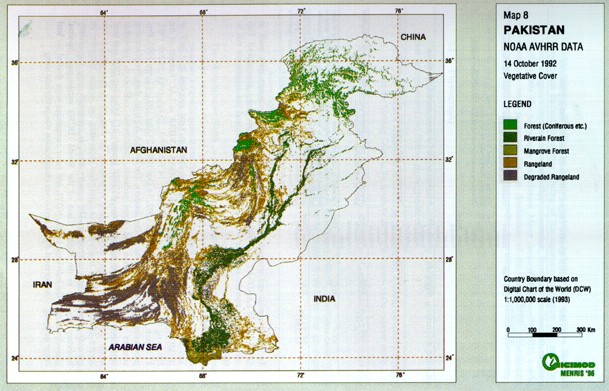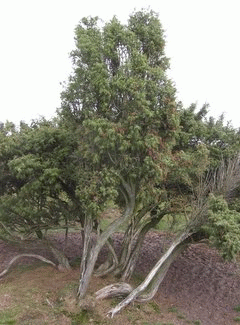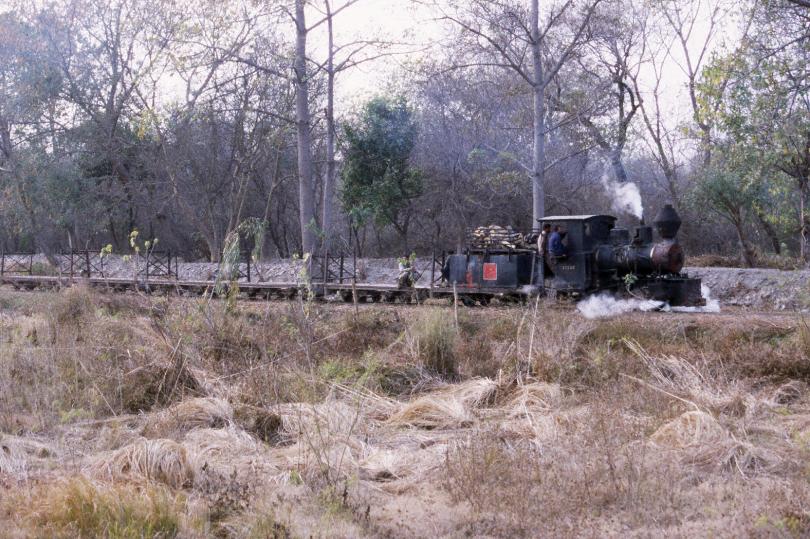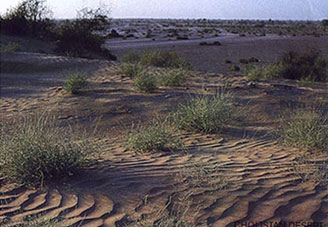

Forests and Jungles of Pakistan
Although the landmass of Pakistan offers diverse soil conditions but the area under forests despite very congenial climatic conditions is barely 4.224 million ha which is 4.8% of the total land area - it should have been 25%. Although farmland trees and linear planting along roads - canals and railways cover an estimated area of 466,000 ha and 16,000 ha respectively, these do not constitute forests within the context of legal, ecological or silvi-cultural / management definition of forests. The situation is also similar, but to a lesser extent, in the case of miscellaneous plantations over an area of 155,000 ha. If the area of these three categories of plantations is excluded from total forest area of 4.224 million ha, then the latter is reduced to 3.587 million ha which is approximately 4.1 % of the total area. The type of forests that exist in Pakistan with relative share are moist and dry temperate: coniferous 40%, scrub 28%, tropical thorn 3.5%, man made irrigated 5%, riverine 7%, mangrove 8% and farm forests 11%
Map showing Forest area of
Pakistan
(Map Credit: UNEP Environment Assessment Programme
for Asia and the Pacific (http://www.rrcap.unep.org))
The following forest types are found in Pakistan:
Littoral and Swamp forests
Tropical dry deciduous forests
Tropical thorn forests
Sub-tropical broad-leaved evergreen forests
Sub-tropical pine forests
Himalayan moist temperate forests
Himalayan dry temperate forests
Sub-alpine forests
Alpine scrub
Littoral and Swamp Forests:
These are gregarious forests of low height found in the Arabian sea around the
coast of Karachi and Pasni in Balochistan. The main species is Avicennia marina
(99%). According to latest estimates, these forest cover an area of 207,000 ha.
Tropical Dry Deciduous Forests: These are forests of low or
moderate height consisting almost entirely of deciduous species. Their canopy is
typically light though it may appear fairly dense and complete during the short
rainy season. This type is found in limited areas of Rawalpindi foothills
carrying this vegetation type. The chief tree species are Lannea (Kamlai, Kembal)
Bombax ceiba (Semal), Sterculia, Flacourtia (Kakoh, Kangu), Mallotus (Kamila,
Raiuni) and Acacia catechu (Kath). Common shrubs are Adhatoda (Bankar, Basuti,
Bansha), Gymnosporia (Putaki) and Indigofera (Kathi, Kainthi).
Tropical Thorn Forests: These are low, open and pronouncedly
xerophytes forests in which thorny leguminous species predominate. This type is
found in the whole of the Indus plain except the driest parts. The major tree
species are Prosopis cineraria (Jhand), Capparis decidua (Karir, Karil),
Zizyphus mauritiana (Ber), Tamarix aphylla (Farash) and Salvadora oleoides (Pilu,
wan). Among them are a large number of shrubs of all sizes. The tree forest
climax is very frequently degraded to a very open, low thorny scrub of Euphorbia
(Thor), Zizyphus (Ber), etc. owing to the universally heavy incidence of grazing
and other biotic factors. Edaphic variants, especially connected with degree of
salinity, shallowness over rock, etc., often occur. A characteristic pioneer
vegetation is developed on inland sand dunes and the semi-deserts of the areas
of least rainfall. On the basis of climax vegetation, the whole Indus basin
plain with the exception of parts of the districts of Sialkot, Gujrat and Jehlum,
consists of tropical thorn forests. The climax species of these forests are
Salvadora oleoides, Capparis decidua, Tamarix aphylla and Prosopis cineraria,
which grow on a wide range of soil textures, from flat deep alluvial soils to
heavy clays, loams and sandy loams. The climate varies from semi-arid (250 to
750 mm rainfall) to arid (less than 250 mm rainfall). The summer temperature in
this tract is as high as 50°C.
Sub-tropical Broad-Leaved Evergreen Forests: These are xerophytes
forests of thorny and small-leafed evergreen species. This type occurs on the
foothills and lower slopes of the Himalayas, the Salt Range, Kalachitta and the
Sulaiman Range. The typical species are; Olea cuspidata (Kau) and Acacia modesta
(Phulai), the two species occurring mixed or pure, and the shrub Dodonaea (Sanatta)
which is particularly abundant in the most degraded areas. Total area of these
forests is estimated to be 1,191,000 ha.
Sub-Tropical Pine Forests: These are open inflammable pine forests
sometimes with, but often without, a dry evergreen shrub layer and little or no
underwood. This type consists of Chir pine (Pinus roxburghii) forests found
between 900 m and 1700 m elevation in the Western Himalayas within the range of
the south-west summer monsoon. It is the only pine of these forests though there
is a small overlap with Pinus wallichiana (Kail, Biar) at the upper limit.
Himalayan Moist Temperate Forests: The evergreen forests of
conifers, locally with some admixture of oak and deciduous broad-leaved trees
fall in this category. Their undergrowth is rarely dense, and consists of both
evergreen and deciduous species. These forests occur between 1500 m and 3000 m
elevation in the Western Himalayas except where the rainfall falls below about
1000 mm in the inner ranges, especially in the extreme north-west. These forests
are divided into a lower and an upper zone, in each of which definite species of
conifers and/or oaks dominate.
In the lower zone, Cedrus deodara (Deodar, diar), Pinus wallichiana, Picea smithiana and Abies pindrow (Partal) are the main conifer species in order of increasing altitude, with Quercus incana (rin, rinj) at lower altitudes and Q. dilatata above 2130 m.
In the upper zone Abies pindrow and Q. semecarpifolia are the dominant tree species. There may be pockets of deciduous broad-leaved trees, mainly edaphically conditioned, in both the zones. Alder (Alnus species) colonizes new gravels and sometimes kail does the same. Degradation forms take the shape of scrub growth and in the higher reaches, parklands and pastures are subjected to heavy grazing.
Himalayan Dry Temperate
Forests: These are open evergreen forest with open scrub undergrowth.
Both coniferous and broad-leaved species are present. This type occurs on the
inner ranges throughout their length and are mainly represented in the
north-west. Dry zone deodar, Pinus gerardiana (Chalghoza) and/or Quercus ilex
are the main species. Higher up, blue pine communities occur and in the driest
inner tracts, forests of blue pine, Juniperus macropoda (Abhal, Shupa, Shur) and
some Picea smithiana (e.g. in Gilgit) are found locally.
Sub-alpine Forests: Evergreen conifers and mainly evergreen
broad-leaved trees occur in relatively low open canopy, usually with a deciduous
shrubby undergrowth of Viburnum (Guch), Salix (Willow, Bed), etc. The type
occurs throughout the Himalayas from about 3,350 m to the timber limit. Abies
spectabilis and Betula utilis (Birch, Bhuj) are the typical tree species. High
level blue pine may occur on landslips and as a secondary sere on burnt areas or
abandoned clearings. Rhododendrons (Bras, Chahan) occur in the understorey but
do not form extensive communities as they do in the central and eastern
Himalaya. Dwarf junipers are often abundant.
Alpine Scrub: Under this type are included shrub formations 1 m to 2 m high
extending 150 m or more above the sub-alpine forests. The characteristic genera
are Salix, Lonicera (Phut), Berberis (Sumbul, Sumblue), Cotoneaster with
Juniperus and occasionally Rhododendron or Ephedra (Asmania).



Juniper Forest (Ziarat/Zargoon - Left) Changa Manga (Centre) - Lal Sohanra (Right)
The Juniper Forests: Near Ziarat, the second largest Juniper forests in the world (after California, USA), some as old as 5000-7000 years are located. Besides a sizeable forest is also found near Zargoon. Read more about the Juniper Forests.
Manmade Forests: Two famous man made forests of Pakistan are the Changa Manga and Lal Sohanra Reserve Forests. Read more about these under following given links:
| Changa Manga Forest | Lal Sohanra Forest |
Related Sites: | Forests/Grasslands/Drylands | Forests of Pakistan |
Attributes: Most of the data above is courtesy "Wild Life of Pakistan - Section 7: Forests of Pakistan |
|
| HOME PAGE | MORE ABOUT OUR LAND | Copyright©JalalsPages - 2008 |